The Bagpipe Society
Blowout 2016
Of course, we’re on familiar ground, indeed literally, in the case of some of our tents, but it’s no bad thing for so much about the Blowout to be much the same. As top-rank Irish piper Liam Og O’Flynn said on that BBC Scotland programme, ‘in piping you’re part of a tradition, and that’s a comfortable place to be’. But no living tradition can be just about doing the same old things, and the Blowout shows how things are also moving forward.
The now traditional basics – our camping area, Vanessa’s wonderful food and the convenient hall are as good as ever, and our programme outline is probably as good as it could be, so I’ll mention some of the highlights and try to bring out what I found significant.
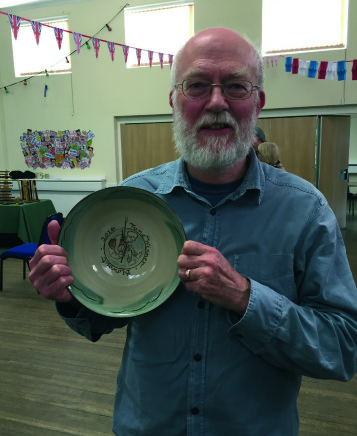
The Friday evening competition is a great settling in exercise. There were two parts: a competition to find a tune to suit our 30th Anniversary, and, second, a performance to bring back “1986 and all that.” Too much to list, but, though all the composed tunes were good, Tim Gleaves’ “Quebec Mazurka”, named after the remote farm near Whitby he used to live in was a worthy winner. But I did enjoy “DAG” – Dave Rowlands, Dave Faulkner and Vicki Swan’s “Friends’ Longdans” on low D pipes and Vicki’s Swedish set, with Sean Jones holding up their music. Jon Swayne and Mike York’s set was typically inventive, playing that first 3/2 hornpipe Jon wrote for the first meeting in 1986, followed by a new hornpipe – and then both together! The winner for performance went to Paul Martin. Good music and good fun sum up the evening, and we either played for dancing or joined the more English session in the dining room.
Vanessa’s wonderful breakfasts are where one of the Blowout’s great features starts – the chat, the chance to exchange information and to learn from other pipers. And afterwards, that continues among the makers’ stands, where the chance to try different pipes is another.
Paul Martin’s workshop was very much working from a tradition. He used his Highland piping background to show some standard grace notes that would work on our pipes. I won’t try to list all his ideas but Paul did emphasise the need to lift the fingers.
It’s a while since we’ve seen French piper Jean-Pierre Rasle at the Blowout as he’s now living well down in the south of France. There he’s been playing in the west of Cantal with local fiddlers and found that their tunes fit so well on his pipes that they must have been pipe tunes once. Given his cabrette training, it was fitting that Jean-Pierre should emphasise the use of “rappel”, that is going down to the bottom note to separate repeated notes and the use of vibrato on long held notes.
Maker Sean Jones has done a lot of work on Uillean/Union/Irish pipes in recent years, and brought enough “practice sets” (bag, bellows and chanter) along for a good number of us to spend the next session having a crack at this legendary instrument. I had such a set years ago, and it was surprising how much came back!
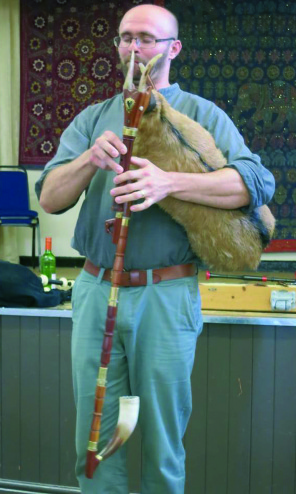
Juraj Dufek’s presentation on the pipes of Slovakia was a window into another very different tradition, that of Eastern Europe. Not only the pipes, but the music itself is very different. Yet it’s also very attractive and well worthy of its recent revival. Juraj demonstrated a little reed pipe used for learning. Such simple instruments must have set thousands of young pipers off down the centuries – remember the passage in Sand’s “Les Maitres Sonneurs”? And it sounds pretty good! Today, perhaps, we have tin whistles. The revival has been very successful in Slovakia, and there are still old players to learn from. Of course many types were used for dancing, but Juraj showed how well some could be used to accompany song. At least one type was very like the French “Cornemuse Landaise”….
The concert in church is always a special occasion, of course. “Estron” began with playing “The Wren” (aka “Love, health, joy and peace”) I very much enjoyed their set, as I did Juraj’s with Paul Martin. Paul has got into Slovak piping, but I’d forgotten just how loud the Great Highland Pipe could be in a stone building! Cliff Stapleton is not only one of the revival’s best Hurdy-gurdy players, but one of its most inventive tunesmiths, so his set with Julian Scott was a treat, especially “Baba Yaga’s Cat”. Finally Callum Armstrong and his group – The Savage Prunes - with pipes, cello and fiddle ended the concert. Their music was inventive, rhythmical and brilliant, but the three instruments speak to the heart as well. Not “folk”, exactly – “Beyond folk”? And why not?
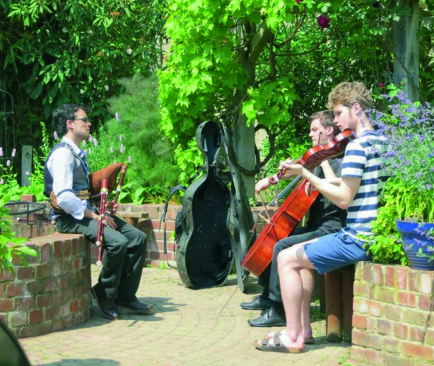
“MoltenAmba” was just the right band for the dancing. Chris Walshaw and his group have been in a good few line-ups and have plenty of experience of what good music is and what works. They have a very sophisticated sound, including some compelling songs, so they’re good to listen to as well as dance to. I really liked a very sleazy mazurka!
Dave Rowland’s D pipe session on Sunday was a companion to last year’s on the Irish music he’s been working on. Last year was variations, this year it was gracing. It’s a matter of what will work on any given chanter, and the aim is to think constantly how to make our piping interesting.
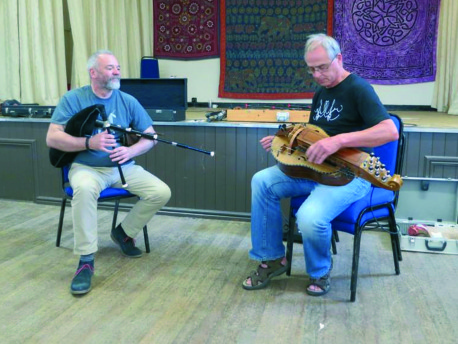
Jean-Pierre Rasle’s second session was concerned with French baroque music. A lot of this was in the British Library as it had been brought over by refugees from the French Revolution. It’s sign of progress that when he first studied this Jean-Pierre had to transcribe it by hand whereas now it’s on line at a French site called “Gallica”.
Throughout the weekend we were often learning from and about various traditions, but not to slavishly follow a “right” way of doing things. For me, the workshops and concerts were a reminder to use the past to improve my own piping using the inspiration of the past as well as the great pipers of today. Further, to appreciate the new directions that some of them are taking piping. And to enjoy music from the wider world of piping. It’s a great morale booster when, as I write, so many in our country are flirting with xenophobia and racism.
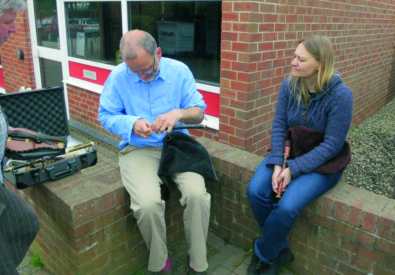
It’s always a sad moment to leave the Blowout, but perhaps a verse form Dave Webber’s “Farewell Song” says it best after this year:
From endings come beginnings, from the old does come the new,
With hope for tomorrow we’ll see our parting through.
Thanks for Ruth Bramley not just for organising the ticketing - but for taking some great photos!
- Data Processing Notice (GDPR)
-
@BagpipeSociety on X (formally known as Twitter)
-
TheBagpipeSociety on Instagram
-
 BagpipeSociety on Facebook
BagpipeSociety on Facebook
Something wrong or missing from this page? Let us know!
